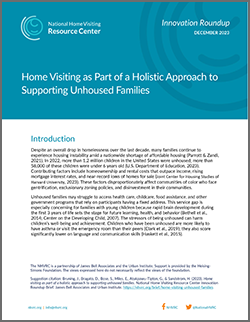
 More than 1.2 million children did not have a fixed, regular, and adequate place to sleep at night in 2022.* Some unhoused families found temporary solutions in emergency shelters or transitional housing programs. Others spent the night in their cars or other unconventional sleeping spaces. A nationwide shortage of affordable housing has driven housing instability among families, even as overall homelessness rates continue to decline. Contributing factors include homeownership and rental costs that outpace income, rising mortgage interest rates, and near-record lows of homes for sale. These factors disproportionately affect communities of color who face gentrification, exclusionary zoning policies, and disinvestment in their communities.
More than 1.2 million children did not have a fixed, regular, and adequate place to sleep at night in 2022.* Some unhoused families found temporary solutions in emergency shelters or transitional housing programs. Others spent the night in their cars or other unconventional sleeping spaces. A nationwide shortage of affordable housing has driven housing instability among families, even as overall homelessness rates continue to decline. Contributing factors include homeownership and rental costs that outpace income, rising mortgage interest rates, and near-record lows of homes for sale. These factors disproportionately affect communities of color who face gentrification, exclusionary zoning policies, and disinvestment in their communities.
Unhoused families may struggle to receive services because they do not have a fixed address, a gap that is particularly concerning for families with young children.
This brief introduces three agencies that take a comprehensive approach to meeting the needs of unhoused families, including the delivery of home visiting services:
- New Moms
- Lydia Place
- Reach Dane
It also provides a statewide look at Minnesota’s efforts to connect home visitors to unhoused children and families, including collaborations with the Ojibwe Nation and various nonprofits. It concludes with a list of strategies for other home visiting programs to consider when serving people in similar circumstances.
*See the full brief for citations.
Suggested citation: Bruning, J., Bragato, D., Bose, S., Miles, E., Atukpawu-Tipton, G., & Sandstrom, H. (2023). Home visiting as part of a holistic approach to supporting unhoused families. National Home Visiting Resource Center Innovation Roundup Brief. James Bell Associates and Urban Institute. https://nhvrc.org/brief/home-visiting-unhoused-families
Acknowledgments: Thank you to Katie Wise, Jennifer Hooper, Amy Selenske, Kristen Tharaldson, and Chandra Bittman for sharing information about their home visiting programs. Thank you to Allison Meisch, Heather Sandstrom, Joelle Ruben, and Jill Filene for shaping and editing the brief, and to Kristine Neurauter for providing formatting support.